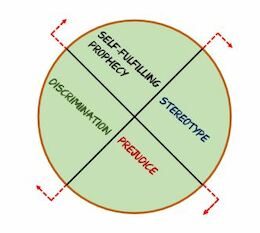Toolbox — For Training and Youth Work
All new tools in your inbox: Be the first to know about new tools for learning with our e-mail notifications.
Exercise, Manual
Healing wheel-chairs
A group exercise involving discussion about stereotyping and prejudicing of any kind in daily life.
Inspired by the Medicine Wheel method of the Aborigins of Canada.
Aims of the tool
1. raise awareness of the negative discriminative power of stereotypes and prejudices;
2. develope participants's skill to identify discriminative discourses;
3. offer a tool of managing and resolving conflicts.
Description of the tool
A. Preparation:
1. Put the 4 chairs in order that they are in the center of the room and that the ones sitting on them will not have visual contact with the other participants in the activity.
2. Have 1 slide of PowerPoint presentation showing the above medicine wheel with 1 title per quarter. Ideally, these titles could be:
a. Stereotype
b. Prejudice
c. Discrimination
d. Self-fulfilling prophecy
3. Divide the blackboard in 4 sectors, each one with the titles of the medicine wheel’s sectors.
B. Instructions:
1. Explain that the aim of this activity is to get acquainted with the power of discriminative discourses, and to be able to identify them in our working environment.
2. Define stereotypes (negative or positive oversimplified generalizations of people who belong to a particular social group), prejudice (negative feeling toward people who belong to a particular social group)
3. To warm up, ask all the participants of the module to say at least one stereotype they can identify from their daily life.
4. Have a second round with prejudices identified in daily life.
5. Have a third (last) round with discriminations identified in daily life.
6. Ask 4 people to sit down at the 4 chairs you have placed in the center of the room.
7. Give each siting participant one different title of the possible 4 from the medicine wheel.
8. Ask the 1st participant to name one stereotype related to the subject that your module covers (i.e sexuality, disability, racism, homophobia, elections etc)
9. Ask the 2nd participant to name one prejudice that derives from this stereotype.
10. Ask the 3rd participant to name a discrimination that results from the mentioned stereotype and prejudice.
11. Ask the 4th participant to name a self-fulfilled prophecy that relates to the referred discrimination.
(EXAMPLE: Stereotype: Women are weak -> Prejudice: Women’s performance in hard work is inferior to the man’s -> Discrimination: Women are misrepresented in a big part of works which are considered masculine, or when they are hired they get lower salaries -> Self- fulfilling prophecy: Women do not apply for jobs considered masculine because they believe they can’t make it)
12. Have a second round with the same exercise but 4 other people.
13. When the 2nd group is finished ask everybody to go back to their places.
C. Debriefing and evaluation:
1. Short review of the activity (you are supposed to take notes on the whiteboard every time a participant mentions one example of the discussed term)
2. Ask participants if they feel that something of the examples mentioned may be exaggerated or surprising, or if they disagree.
3. Ask if they have ever thought of these events as intersecting and interconnected.
4. Ask if they can recall anything similar from the work.
5. Ask the role that their work can play in dealing with these stereotype circle effect.
6. Ask participants to share feelings and opinions from the activity.
Available downloads:
Disclaimer
SALTO cannot be held responsible for the inappropriate use of these training tools. Always adapt training tools to your aims, context, target group and to your own skills! These tools have been used in a variety of formats and situations. Please notify SALTO should you know about the origin of or copyright on this tool.
Tool overview

http://toolbox.salto-youth.net/1571
This tool is for
Any group of people working or being trained in the same environment. It is designed to comfort with the needs of all ages.
and addresses
Social Inclusion, Disability, Anti-Racism, Intercultural Learning, Gender issues
It is recommended for use in:
Youth Exchanges
Training and Networking
Materials needed:
1. 4 chairs
2. PowerPoint presentation with a medicine wheel that conforms to the desired subject.
3. Whiteboard and markers for whiteboard
Duration:
The process can last as long as the facillitators/trainers need, but it is suggested to last no more than 75 minutes and no less than 30 minutes.
Behind the tool
The tool was created by
Anargyros Papadopoulos (inspired by the Medicine Wheel of the Aborigins of Canada)
in the context of
the CHARM II project (Civic Help for Anti-racist Measures), which was organized between 2013 and 2014 in Greece, Bulgaria, Italy, Spain, Poland and Lithuania, with financial support from the Fundamental Rights and Citizenship Programme of the European Uni
The tool has been experimented in
the in-country trainings of the CHARM II project in Greece.
The tool was published to the Toolbox by
Anargyros Papadopoulos (on 27 October 2014)
and last modified
13 October 2014
Comments
No comments have been posted yet.
If you want to comment on this tool, you need to be signed in with your MySALTO account. Sign in now